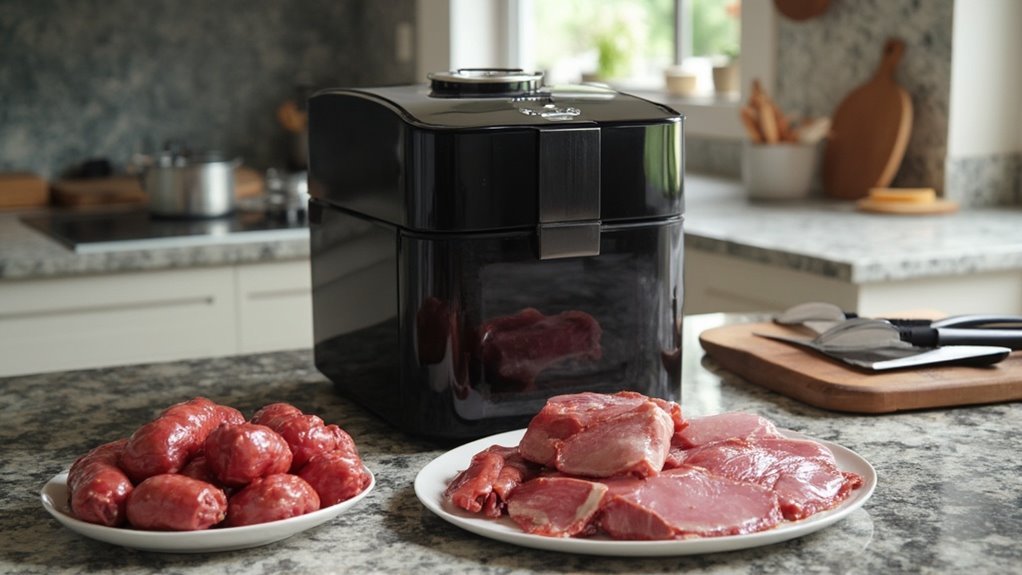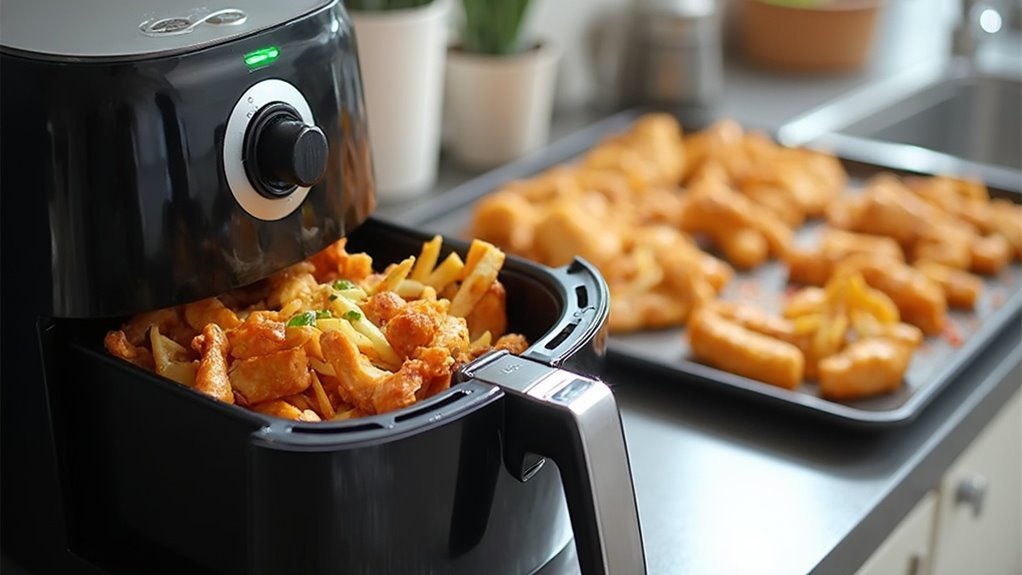When using an air fryer, avoid high-fat meats, wet batters, and leafy greens to prevent smoke and messes. Overcrowding hinders even cooking, so maintain spacing. Clean the air fryer after each use to avoid buildup affecting performance. Guarantee proper food arrangement; use single layers to achieve desired crispness. Cook high-fat meats at 360-400°F, but leafy greens require lower temperatures. Following these guidelines guarantees safety and consistency. Discover more best practices for ideal air frying results.
Key Takeaways
- Avoid high-fat meats in air fryers to prevent excess smoke and grease fires.
- Wet batters can cause splatter; use thicker batters and avoid overcrowding for even cooking.
- Use a lower temperature and secure lightweight vegetables to prevent overcooking.
- Regularly clean and maintain the air fryer to ensure efficient operation and safety.
- Follow manufacturer guidelines and avoid using metal utensils to protect non-stick surfaces.
High-Fat Meats and Sausages

Although air fryers are a popular kitchen appliance, using them to cook high-fat meats and sausages requires careful consideration to ascertain safety and ideal results.
The high fat content in these foods can cause excess smoke and, in some cases, grease fires. To mitigate this, verify your air fryer is clean and free from oil buildup before cooking. Set an appropriate cooking temperature; typically, 360-400 degrees Fahrenheit is effective for most high-fat meats.
Monitor your food closely to avoid overcooking, as air fryers can cook faster than traditional methods. Properly spacing items in the basket will also help achieve even cooking.
Wet Batters and Tempura
When using an air fryer, be cautious with wet batters as they can cause batter splatter, leading to a mess and potential safety hazards.
Additionally, wet batters may result in uneven cooking, with some parts remaining undercooked.
For a safer and more consistent outcome, consider using alternative coating methods such as dry breadcrumbs or panko.
Batter Splatter Concerns
Using an air fryer for wet batters like tempura can be tricky due to the potential for batter splatter, which not only creates a mess but also poses safety risks.
To tackle this, understand batter types and opt for thicker batters that adhere better, minimizing splatter. Tempura enthusiasts can achieve crisp results by chilling the batter, which enhances its stickiness and reduces the likelihood of splatter.
For effective splatter prevention, line the air fryer basket with parchment paper or use a mesh cover to contain the batter. Ensuring the food is well-drained before coating it in batter also helps.
Uneven Cooking Risks
While air fryers offer a healthier alternative to traditional frying methods, they can present challenges such as uneven cooking, especially with wet batters like tempura.
These batters can lead to airflow obstruction, which is vital for the even distribution of heat. The air fryer relies on hot air circulation, and when airflow is blocked, certain areas might cook faster than others, causing inconsistent results. Temperature differences further exacerbate this issue, as the outer layers may crisp while the inside remains undercooked.
To mitigate these risks, avoid overcrowding the fryer basket.
Make sure that each piece is adequately spaced to allow ideal air movement. This freedom in arrangement enhances uniform cooking, helping you achieve consistently crispy results without sacrificing the benefits of air frying.
Alternative Coating Methods
Although traditional wet batters like tempura pose challenges in an air fryer, alternative coating methods can help achieve similar crispy textures.
You can opt for dry coatings such as panko breadcrumbs or crushed nuts, which provide a crunchy exterior without the mess of wet batters. These alternative coatings not only prevent the batter from slipping off but also offer healthy options by reducing oil absorption.
A light spray of oil guarantees even browning, enhancing the crispiness without compromising health. For a more nutritious twist, try coating with whole grain or almond flour.
Evidence suggests these options maintain the desired crunch while aligning with health-conscious eating. Embrace these methods for a delicious, hassle-free air frying experience that doesn't sacrifice flavor.
Leafy Greens and Light Vegetables
When air frying leafy greens and light vegetables, exercise caution to confirm both safety and ideal cooking results. These foods can easily overcook or fly around inside the fryer due to their lightweight nature.
To enhance vegetable crispiness without compromising safety, follow these guidelines:
Use these tips for crispy, safe air-fried greens: secure, control temp, apply light oil.
- Secure Cooking: Use a mesh basket or skewer to keep leafy greens contained, preventing them from circulating and burning.
- Temperature Control: Set your air fryer to a lower temperature, around 300°F, to confirm even cooking and avoid charring your light vegetables.
- Oil Application: Lightly coat greens with oil to promote crispiness while maintaining moisture, but avoid over-saturation, which can lead to sogginess.
Cheese and Dairy-Based Dishes

Cheese and dairy-based dishes can be successfully prepared in an air fryer, but they require careful attention to prevent mess and guarantee ideal flavor. Start by ensuring your cheese is securely wrapped or battered to avoid excessive cheese melting and drips.
Using parchment paper can also help maintain a clean air fryer basket. Opt for hard cheeses like cheddar or mozzarella, which melt uniformly and enhance taste.
If you're exploring dairy alternatives, many vegan cheeses behave similarly to traditional cheeses, offering a guilt-free option. Adjust the cooking time and temperature to match the specific melting point of the cheese or alternative you choose.
With mindful preparation, you can enjoy the freedom of creating delicious, mess-free cheese dishes using your air fryer.
Small Grains and Pasta
While many might assume that an air fryer is unsuitable for small grains and pasta, these can be cooked effectively with the right techniques. Grains such as quinoa and couscous, along with pasta alternatives like zucchini noodles, can be air-fried with precision.
Small grains and pasta can be air-fried with precision using the right techniques.
Here's how you can achieve the best results:
- Grain Preparation: Soak your grains in water to guarantee even cooking. This step is essential for achieving desired texture.
- Oil and Seasoning: Lightly coat grains or pasta alternatives with oil and your choice of seasoning. This prevents sticking and enhances flavor.
- Proper Layering: Arrange grains and pasta in a single layer within the fryer basket. Overcrowding leads to uneven cooking.
These steps let you enjoy diverse textures and flavors, embracing culinary freedom.
Toasted or Seasoned Nuts
Preparing grains and pasta in an air fryer opens up a world of possibilities, and crafting toasted or seasoned nuts is no different. The air fryer's rapid circulation guarantees even toasting, enhancing flavors and texture. To explore toasted nut varieties, you can choose almonds, walnuts, or cashews. Each nut offers unique nutritional benefits and taste profiles.
| Nut Type | Suggested Seasoning |
|---|---|
| Almonds | Paprika and Sea Salt |
| Walnuts | Cinnamon and Honey |
| Cashews | Chili Powder and Lime |
Follow seasoned nut recipes precisely to avoid burning and maintain nutritional integrity. Preheat your air fryer, spread nuts evenly, and set the temperature to around 325°F for ideal results. With these guidelines, create delightful snacks that satisfy your taste and dietary preferences.
Overcrowding and Proper Spacing

When you overcrowd your air fryer, you hinder ideal air circulation, leading to uneven cooking.
Studies show that proper spacing of food items guarantees consistent heat distribution, which is vital for achieving the desired texture and safety.
To maintain efficiency and safety, always follow the manufacturer's guidelines on spacing and capacity.
Optimal Air Circulation
Ensuring ideal air circulation in your air fryer is essential for achieving perfectly cooked meals. To optimize airflow, apply effective circulation techniques, which prevent overcrowding and allow your food to cook evenly.
Here's a straightforward approach to enhance your air fryer's performance:
- Space Items Evenly: Arrange food in a single layer without stacking. This guarantees each piece gets exposed to the hot air.
- Avoid Overloading: Filling the basket to the brim hampers airflow. Keep it about half full for best results.
- Use Accessories Wisely: Utilize racks or baskets designed for air fryers to elevate food, promoting better air circulation.
Preventing Uneven Cooking
While using an air fryer, avoiding overcrowding is crucial to prevent uneven cooking.
You've got to give each piece of food its space to allow hot air to circulate freely. When you pile food on top of each other, the air can't reach every surface, resulting in inconsistent textures and cooking times.
For best results, arrange food in a single layer, guaranteeing proper food placement. This method guarantees the food cooks evenly and achieves that desired crispness.
Regular Maintenance and Cleaning
To keep your air fryer in prime condition, regular maintenance and cleaning are essential. Conduct air fryer inspections frequently to catch potential issues early.
Regular maintenance and cleaning are crucial to ensuring your air fryer remains in optimal working condition.
Here are three maintenance tips to guarantee your appliance's longevity:
- Clean after each use: Remove food debris and grease by washing removable parts with warm, soapy water. This prevents buildup that can affect performance.
- Inspect the heating element: Regularly check for residue or blockage. A soft brush or cloth can keep the element clean and efficient.
- Wipe the exterior: Use a damp cloth to clean the outer surfaces, making sure all vents are clear for maximum airflow.
Conclusion
Mastering air fryer safety is like wielding a mighty culinary superpower. Avoiding high-fat meats and wet batters, steering clear of leafy greens, and resisting the urge to overcrowd guarantees you won't end up with a kitchen disaster of epic proportions. Regular maintenance transforms your air fryer from a mere appliance into an invincible fortress of culinary delight. By following these evidence-based guidelines, you'll achieve not just good, but spectacularly safe and delicious results every time.
